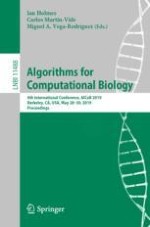2019 | Book
Algorithms for Computational Biology
6th International Conference, AlCoB 2019, Berkeley, CA, USA, May 28–30, 2019, Proceedings
Editors: Ian Holmes, Carlos Martín-Vide, Miguel A. Vega-Rodríguez
Publisher: Springer International Publishing
Book Series : Lecture Notes in Computer Science
